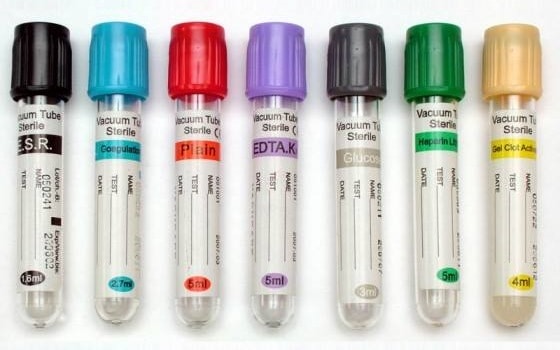The evacuated tube system for blood collection in use for various laboratory tests consists of tubes of various sizes, with color coded tops indicating tube contents. Most blood collection tubes contain an additive that either accelerates clotting of the blood (clot activator) or prevents the blood from clotting (anticoagulant).
The list below lists the most commonly used blood collection tubes, their additives and uses in laboratory:
1. Red
The red bottle is less common – it is used for biochemistry tests requiring serum which might be adversely affected by the separator gel used in the yellow bottle.
- Additive: None or contains silica particles which act as clot activators.
- What additive does: Clot activator promotes blood clotting with glass or silica particles.
- Laboratory Uses: Serum testing (glucose, cholesterol, triglycerides, HDL, potassium, amylase, alkaline phosphatase, BUN, CK, liver enzymes), blood bank, serology (RH Typing, Antibody screening, Red Cell Phototyping, DAT, RPR, monospot, rheumatoid factor, ANA)
2. Yellow
- Additive: anticoagulant SPS (Sodium Polyanetholsulfonate) & ACD (acid citrate dextrose)
- What additive does: Prevents the blood from clotting and stabilizes bacterial growth.
- Laboratory Uses: Blood and bodily fluid cultures (HLA, DNA, Paternity)
Tubes with SPS – For Blood and bodily fluid cultures (HLA, DNA, Paternity). The SPS aids in the recovery of microorganisms by slowing down/ stopping the actions of complement, phagocytes, and certain antibiotics.
Tubes with ACD are for cellular studies, HLA typing, paternity testing.
3. Light Blue
The blue bottle is used for haematology tests involving the clotting system, which require inactivated whole blood for analysis.
- Additive: Sodium Citrate
- What additive does: Binds and remove calcium to prevent blood from clotting
- Laboratory uses: Coagulation (clotting process-P.T)
PT (Prothrombin Time – evaluates the extrinsic system of the coagulation cascade & monitors coumadin therapy)
APTT/ PTT (Activated Partial Thromboplastin Time – evaluates the intrinsic system of the coagulation cascade & monitors heparin therapy)
FDP (Fibrinogen Degradation Products)
TT (Thrombin Time)
Factor assays
4. Green
This less commonly used bottle is for biochemistry tests which require heparinised plasma or whole blood for analysis.
- Additive: Heparin (Sodium/Lithium/Ammonium)
- What additive does: Inhibits thrombin formation to prevent clotting
- Laboratory uses: Chemistry Testing (Plasma determinations in chemistry) : ammonia, carboxyhemoglobin & STAT electrolytes, chromosome screening, insulin, renin and aldosterone
5. Lavender
These bottles are generally used for haematology tests where whole blood is required for analysis.
- Additive: EDTA (Ethylenediaminetetraacetic Acid)
- What additive does: Removes calcium preventing clotting of blood
- Laboratory uses: Hematology testing (ESR, CBC w/diff., HgBA1c)
blood film for abnormal cells or malaria parasites, reticulocytes, red cell folate, Monospot test for EBV, parathyroid hormone (PTH)
6. Grey
- Additive: Potassium oxalate and Sodium fluoride
- What additive does: Sodium fluoride acts as an antiglycolytic agent to ensure that no further glucose breakdown occurs within the sample after it is taken. Potassium oxalate removes calcium and acts as an anticoagulant.
- Laboratory uses: Chemistry testing, especially glucose(sugar) and lactate, Glucose tolerance test (GTT)
7. Royal Blue
- Additive: Sodium Heparin also Sodium EDTA
- What additive does: Inhibits Thrombin formation to prevent
- Laboratory uses: Chemistry trace elements (such as Zinc, Copper, Lead and Mercury), toxicology, and nutritional chemistry testing
8. Black
- Additive: Sodium Citrate
- What additive does: Forms calcium salts to remove calcium
- Laboratory uses: paediatric ESR





No comments:
Post a Comment
Due to the high number of spammy comments we have decided to initiate comment moderation so that we can maintain our quality standards and make good environment for our visitors. Please leave your comment